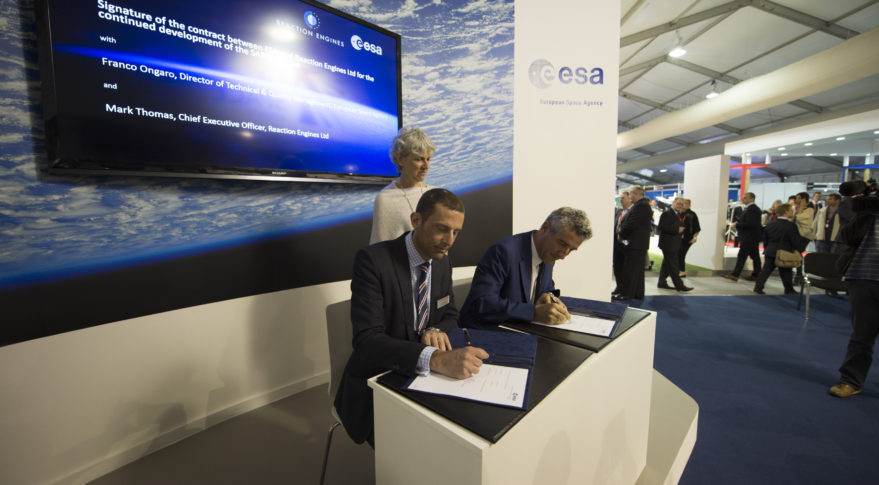Three Years Later, Reaction Engines Gets Promised UK Investment in Rocket Technology

FARNBOROUGH, England – The European Space Agency on July 12 said it would release 10 million euros ($11 million) in support to Reaction Engines Ltd., whose space plane/hypersonic aircraft engine project in 2013 won substantial British government backing – none of which had been received until recently.
The company has since secured BAE Systems as a 20 percent shareholder and technology partner.
Franco Ongaro, ESA's director of technical and quality management, said a further 10 million euros could be spent through ESA to stimulate subcontractor work in Europe on Reaction Engines' Synergetic Air-Breathing Rocket Engine (SABRE) among other ESA member states.
At a briefing here during the Farnborough Air Show, Ongaro and Reaction Engines Chief Executive Mark Thomas said the new funding will help the company complete a preliminary design review of the SABRE engine in 2018, with a ground demonstration in 2020. [The Skylon Space Plane in Pictures]
The British government in mid-2013 announced it would make 60 million British pounds ($78 million) in grants available to Reaction Engines to pursue development of SABRE and its key technology — a heat exchanger designed to take incoming air at 1,000 degrees Celsius and cool it to minus 150 degrees Celsius in one one-hundredth of a second, all the while preventing ice buildup.
At a briefing here during the Farnborough Air Show, Ongaro and Reaction Engines Chief Executive Mark Thomas said the new funding will help the company complete a preliminary design review of the SABRE engine in 2018, with a ground demonstration in 2020.
ESA's investment is part of the British government's commitment. ESA has been acting as a technology advisor to the British government on SABRE since 2008. In 2012, ESA oversaw testing of the pre-cooler and lent its credibility to Reaction Engines' long-held claim of a breakthrough in low-cost, reusable rocket technology.
Get the Space.com Newsletter
Breaking space news, the latest updates on rocket launches, skywatching events and more!
The government had said that 35 million pounds would be released in the 2014/2015 fiscal year, with the remaining 25 million pounds to come a year later. It never happened.
The U.K. Parliament's Science and Technology Committee in June chastised the government for announcing a daring decision that, at the time of the committee's report, had shown no follow-up. The committee said the delay might have cost Reaction Engines part of its lead on future competitors, especially in the United States.
The U.S. Defense Department has been reserved in its public assessment of SABRE, but has said the technology could find applications as a hypersonic-delivery system and perhaps other uses.
To help secure U.S. government and U.S. industry backing, Reaction Engines on July 11 announced the creation of a U.S. subsidiary, with Adam Dissel, formerly system architect for responsive space at Lockheed Martin Space Systems, named president.
The parliamentary report referenced communications breakdowns between U.K. government agencies and Reaction Engines as one possible cause of the funding bottleneck. But during the July 12 briefing, Thomas said it was mostly due to the European Commission process of approving state aid to companies.
"In aerospace we are used to long-duration funding programs," Thomas said. "When the funding commitment from the U.K. government was announced in 2013, we knew it wasn't going to be a fast process. There were many, many hoops to jump through. I guess the biggest one was the EU state aid approval. That took a lot of effort from the U.K. government, the European Space Agency and ourselves to make sure we cleared that hurdle. We knew it was going to be a long process. The funds are now flowing."
Thomas said the investment is based on the company hitting specific development milestones. "As long as we hit the milestones, we're in good shape," he said.
BAE Systems in November 2015 invested 20.6 million British pounds into the company for a 20 percent equity stake has been a technology development partner for SABRE.
Reaction Engines in 2013 had estimated that a demonstrator project could cost as much as 300 million British pounds. But Thomas said the company has reassessed the cost of the demonstrator and now believes it can be completed at a much-lower cost. He declined to provide an estimate.
"We are moving forward in a significant way on a technology development that is revolutionary in terms of space transportation," Ongaro said. "We came to a success in 2012 with the demonstration of a unique cooler, which most people believed could not work. This opened the way to the full development of the engine.
"This is what we like to call a game changer. We are very happy to go ahead. The [U.K. Space Agency] will invest in parallel to us, on a national basis, for some technology development. We have a further 10 million euros in our [technology development] program to look for European technologies to complement the work at Reaction Engines."
Thomas said Reaction Engines was "very interested in collaboration. We know the project will only be successful because of collaboration. We have made a start on that through our BAE Systems working partnership."
This story was provided by SpaceNews, dedicated to covering all aspects of the space industry.
Join our Space Forums to keep talking space on the latest missions, night sky and more! And if you have a news tip, correction or comment, let us know at: community@space.com.
Peter B. de Selding is the co-founder and chief editor of SpaceIntelReport.com, a website dedicated to the latest space industry news and developments that launched in 2017. Prior to founding SpaceIntelReport, Peter spent 26 years as the Paris bureau chief for SpaceNews, an industry publication. At SpaceNews, Peter covered the commercial satellite, launch and international space market. He continues that work at SpaceIntelReport. You can follow Peter's latest project on Twitter at @pbdes.










